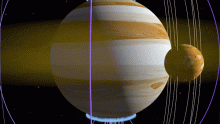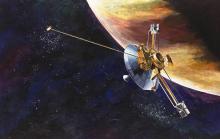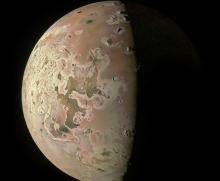Listen to today's episode of StarDate on the web the same day it airs in high-quality streaming audio without any extra ads or announcements. Choose a $8 one-month pass, or listen every day for a year for just $30.
You are here
Jupiter at Opposition
Jupiter is the “big brother” of the solar system. It’s bigger and heavier than its sibling planets — more than twice as massive as all of them combined. And it’s also older; it might have been born tens of millions of years before Earth and some of the other planets.
Jupiter was born much farther from the Sun than Earth and the other inner planets. At that range, it was cold enough for ices to clump together with rock and metals to make Jupiter’s giant core. The core quickly grew to about seven times the mass of the present-day Earth.
The core’s gravity was strong enough to pull in enormous amounts of hydrogen and helium gas — leftovers from the formation of the Sun. That allowed Jupiter to grow in a hurry. Some models say it reached full planethood within about three million years of the Sun’s birth. That’s not long when you consider that the Sun is about four and a half billion years old. The other planets came later — first the other giant outer planets, then the rocky inner planets — including Earth.
Jupiter is putting in its best showing of the year this week. It lines up opposite the Sun, so it rises around sunset and is in view all night. It looks like a brilliant star — only the Moon and Venus outshine it. Jupiter is low in the east as darkness falls. It reaches its highest point in the sky in the wee hours of the morning, and is low in the west at dawn.
More about Jupiter tomorrow.
Script by Damond Benningfield





